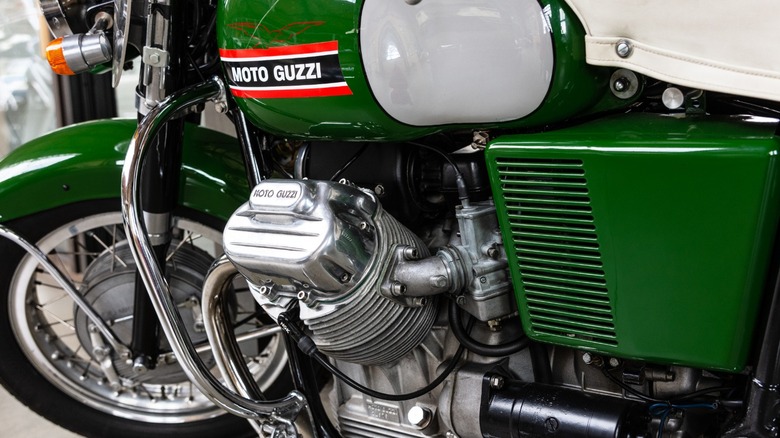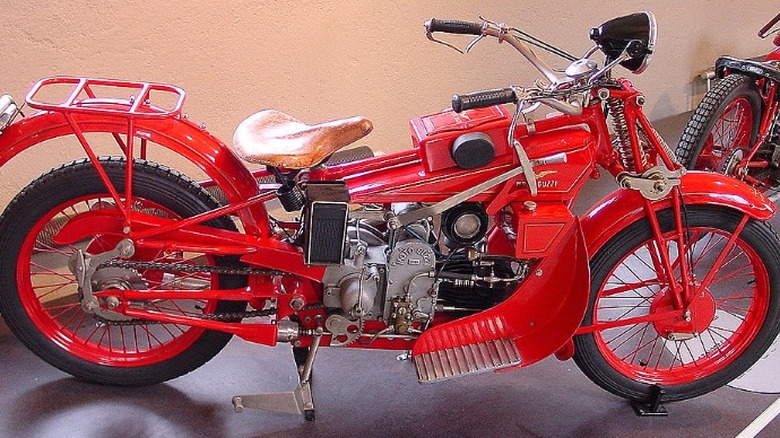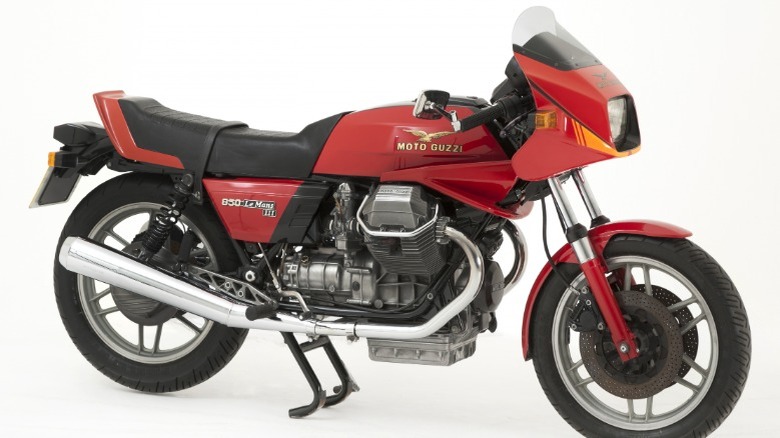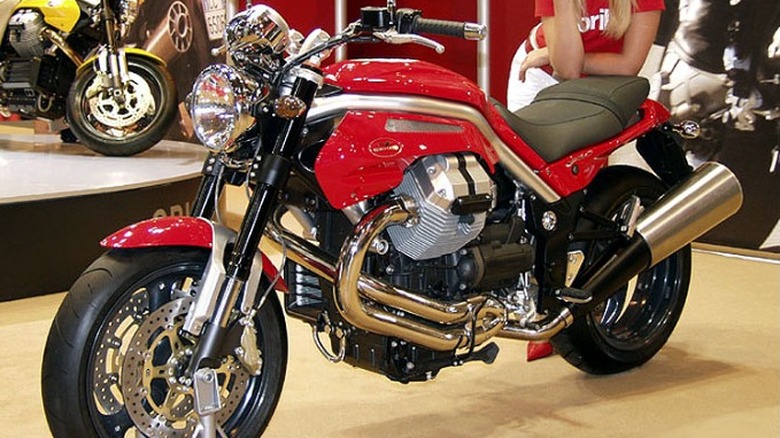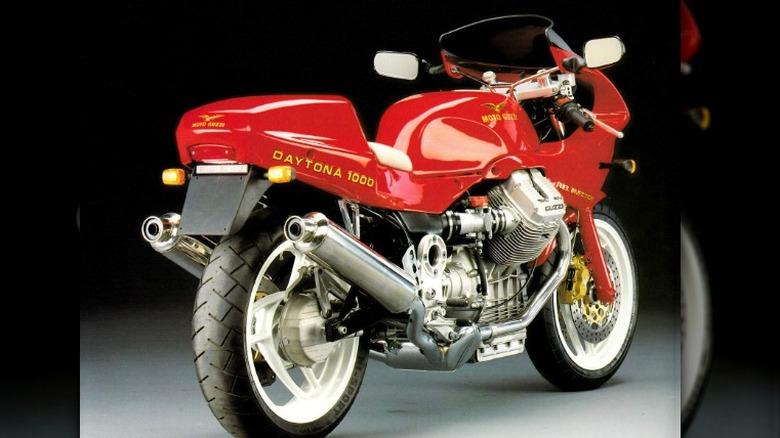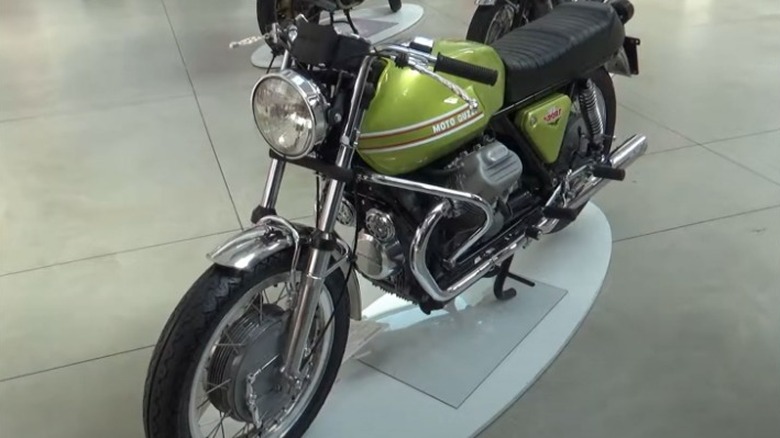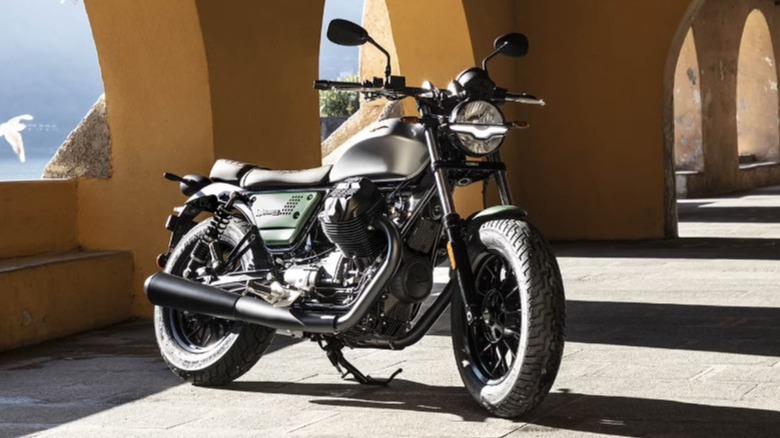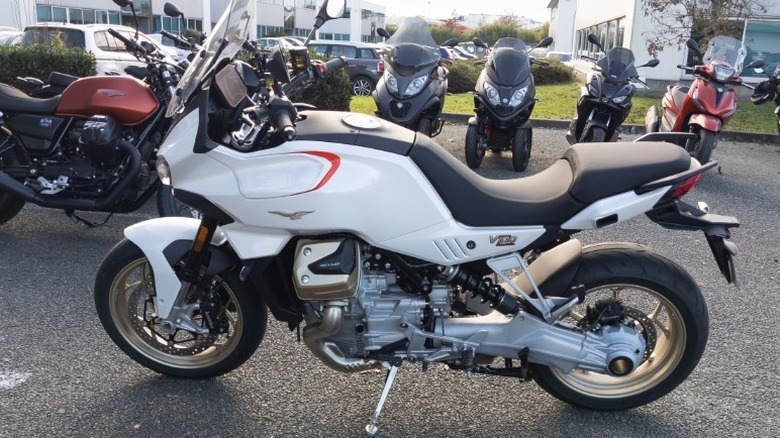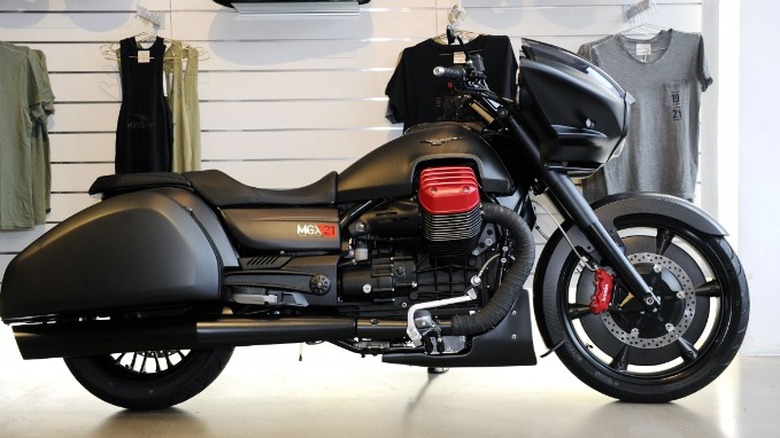The 8 Best Moto Guzzi Motorcycles Ever Made
The Italian motorcycle manufacturer Moto Guzzi has been crafting fine two-wheeled machines for decades from its home base in Genoa. Despite making motorcycles through the years through bull and bear economies and making machines that also win races, Moto Guzzi has never been a major player in the market compared to companies like Harley-Davidson or Yamaha. Still, Moto Guzzi motorcycles are highly desirable machines that perform well and come with a bit of style in the Italian way.
Moto Guzzi's origins lie in the years after World War I when a trio of veteran pilots with a vision for a new Italian motorcycle set up shop in 1921. Sadly, one of the men lost his life in an aviation accident, and a tribute to his memory was made part of the Moto Guzzi as an eagle with wings outspread above the company name (via Ultimate Motorcycling). The first bikes came in 1924 and have been in production ever since.
Since the early '70s, a transverse v-twin design has been the hallmark of the brand, with Moto Guzzi motorcycles being instantly recognizable from the pair of cylinders protruding out from under either side of the fuel tank. Ownership has changed hands a few times, including a stint under automotive legend and wizard Alejandro Detomaso, and today it is owned by Piaggio, producer of the famous Vespa scooter line (via Moto Guzzi). Today's Moto Guzzi is a stylish and modern machine drawing from a century of development, and these eight models from the company are the best ever made.
Moto Guzzi 500 GT Norge
Just like any start-up company, the early days of Moto Guzzi involved plenty of trial and error, figuring out what would and would not work until they got it right. While some companies of the era started with small and economical engines, Moto Guzzi broke from the pack immediately with a 499cc single and the 1928 500 GT Norge (Norway). It was a 4-stroke engine using an overhead cam design with four valves, rare for any motorcycle of the period. Another advanced design element was the sprung rear wheel, which used a unique setup in which the rear wheel suspension used a spring under the engine and friction dampers at the rear. Bikes with rear suspensions were nothing new but were still rare at the time as most designs compromised handling too much, according to Moto Collection.
Moto Guzzi was heavily involved in racing at the time. But Carlo Guzzi's brother, Guiseppe, preferred to use the machines for touring and adventure riding. According to the manufacturer, he held disdain for hot weather and often used summer holiday periods to take one of his motorcycles on long rides to cooler locales among the mountains of Europe. As a sort of publicity stunt, their 500cc machine was named Norge after the airship of the same name that had crossed the North Pole in 1926. But later, to prove the mettle of the machines they were building, Guiseppe rode a 500 GT Norge cross-country until he reached the arctic circle on a Moto Guzzi, an extremely audacious adventure for the time.
[Featured image by Serge PIOTIN via Wikimedia Commons | Cropped and scaled | CC BY-SA 2.5]
Moto Guzzi 850 Le Mans
The motorcycles of the '70s pushed the boundaries in many ways of what these machines were and what they could do with the right engineering and design. One of the most striking motorcycles of the day was the Moto Guzzi 850 Le Mans, and it also happened to be among the fastest. Taking cues from the modified bikes of the '50s and '60s called cafe racers, the 850 Le Mans came with this styling right out of the factory.
In 1978, the Le Mans was not a cheap bike. Timeless 2 Wheels tells us the list price of $3,679 translates to $16,342 in today's money, which puts it in the upper echelon of sports bikes from any time. The 850cc v-twin engine, featuring the signature Moto Guzzi transverse mounting, produces 80 horsepower which gives it a top speed of 126 mph. This put it in superbike territory for the years 1976 through 1978 in which it was produced. It also came equipped with a novel brake setup. With dual discs up front and a single disc in the rear, the brake pedal operated the rear disc and one of the front discs together. The handlebar brake lever only operates the other front disc. While it took some getting used to, riders came to love the setup and good stopping power, often using the front lever only for emergency stops. For anyone looking for a classic bike that will stand out in a crowd, it would be hard to do better than this one.
Moto Guzzi Griso 1100
For years Moto Guzzi has produced a variety of very nice cruisers and sportbikes, but the Griso 1200 is a difficult one to stick neatly into any one box. The Griso is powered by an air-cooled v-twin engine with 1,151cc displacement. Early models had 1,064cc engines with four valves and displacement was later bumped up along with an additional two valves per cylinder. It is a big roadster with sporty styling that steers clear of the overwrought cruiser aesthetic popular on big baggers and American-style cruisers. Rider Magazine says this style is called Techno Custom by some in the motoring press. Regardless of what that is supposed to mean, it looks cool.
Many bikes exist that are faster than the Griso and more come equipped with more accessories and options. But no other bike on the market looks quite like the Griso. It is aggressive and stylish with a relaxed riding position and an engine that may not be the most powerful, yet it is powerful enough to pull you and the bike along comfortably with its 108 horsepower and 80 lb-ft of torque (via Bike Social). What makes the Griso unique is that it is a bike meant for long rides and relaxed cruising but is adept and capable of being swung around through the twisties on demand. It straddles a line in a way that not many bikes do, but that is what makes it a great Moto Guzzi.
[Featured image by StealthFX via Wikimedia Commons | Cropped and scaled | Public domain]
Moto Guzzi Daytona 1000
Moto Guzzi has a long history of making relaxed cruisers and excellent sport bikes, with many machines engaged in racing and winning as well. But when the Japanese came on full force with superbikes such as the GSXR, Ninja, and CBR900, Moto Guzzi kind of just kept on doing what it had for years. The company might have continued if not for Dr. John Wittner, an American.
Dr. Wittner was not an engineering guru brought in to boost horsepower. Cycle World says he was a dentist with a Moto Guzzi hobby and a knack for winning on the track when he wasn't pulling canines and molars. Though he was a dentist, he also held a degree in mechanical engineering and put it to use in racing. Moto Guzzi was not the obvious choice of motorcycle, but he made them work. Dr. Wittner was so successful that Moto Guzzi brought him to Italy to help engineer a new superbike for the company and the result was the Daytona 1000.
The engine in the Daytona shares few parts with other Moto Guzzi engines and it employs a unique four-valve system with camshafts installed high on the cylinders with extra short pushrods actuating rockers that are more of a rotating shaft than an arm. It is fuel-injected and good for 95 horsepower and a 145 mph top speed, making it the most powerful Moto Guzzi up to that point (via Motorcycle Classics). The Daytona proved to be a world-class machine with excellent handling and brisk acceleration, but its limited production of 1,000 bikes from 1992 to 1995 means they are hard to come by today.
Moto Guzzi V7 Sport
Aside from the very first motorcycle produced, the V7 Sport from Moto Guzzi could be considered the most important bike the company ever made. Most significant about the V7 is that it debuted the now iconic transverse v-twin the company is so well known for producing. In developing this bike, Moto Guzzi had somewhat withdrawn itself to reassess its products and work diligently to come up with something new and impressive. The v-twin is the result of this effort.
The new big v-twin engine is an unusual configuration and it is an early example of engineers using the engine as a stressed member integral to the frame. Its first use was in the 750 Ambassador, which, according to Silodrome, was built to market to police departments and challenge the Harley-Davidsons that dominated at the time. American dealers loved the new engine and pressured Moto Guzzi to produce a consumer version. That was the 1971 V7 Sport, hailed by some as the first factory-built cafe racer. Not only was it beautiful, but it was also fast. Motorcycle Classics reports that when put up against its rival Ducati, Honda, Laverda, and Kawasaki bikes, the Moto Guzzi was the fastest. While it left production in 1974, its contribution to the early superbike trend is undeniable.
Moto Guzzi V9 Bobber
Currently in production, the Moto Guzzi V9 Bobber is an outstanding bike for those who want a good road cruiser in the middle of the range. It is not super small and light, nor is it cumbersome and heavy, which makes it great for commuting and leisurely backroad cruises. It is called a bobber to resemble the customization trend in which certain models are stripped of almost everything nonessential with trimmed fenders and often with single seats and matte paint finishes. Timeless 2 Wheels states the style originated in the '20s and gained notoriety in the Marlon Brando flick "The Wild One."
The popularity of the custom scene led many manufacturers to release bobber-style bikes, including this one. Web Bike World says this model comes with an 853cc air-cooled v-twin good for 64 horsepower. It is not the fastest and most powerful bike, but the v-twin is torquey and smooth. Aside from the modern drivetrain and engine management components, the V9 Bobber is simple and down to Earth with a solid black paint scheme and bare-bones look. Yet it is one of the most attractive bikes in its class and the perfect blend of style, purpose, and value.
Moto Guzzi V100 Mandello
The modern bikes coming from Moto Guzzi's factories continue to be as innovative and stylish as ever. In the current lineup is a model that stands as a showcase of technology called the Moto Guzzi V100 Mandello. The V100 is new for 2023 and, much like many Moto Guzzi's, is difficult to categorize. Furthermore, it features some never before seen features and a high degree of technology on board.
The V100 Mandello is a sport touring motorcycle ready for a long ride through the alps but with plenty of grunt to get over the crests and onto the next hill. It does, of course, come with a transverse v-twin, but this one is liquid-cooled and its displacement is just over a liter at 1,042cc. Öhlins provides ride control on the inverted forks and single rear shock, both of which employ semi-active damping. All of that combined with Brembo disc brakes with ABS front and rear makes a bike that is well-behaved and comfortable, but capable of getting along at a fast clip when needed. Motorcycle News says the engine's internals have been made lighter than previous engines, making it a bit quieter and smoother while boosting acceleration. It is also the first motorcycle to come with adaptive aerodynamics, with panels on either side of the fairing that raise and lower with speed to deflect air around the rider to reduce drag. A special edition with paint to match Italian Navy F-35 fighter jets will also be available to 1,913 buyers.
Moto Guzzi MGX-21 Flying Fortress
The mainstay of Moto Guzzi over the years has been in the middle of the range with plenty of 750 and 850cc models dominating the lineup. Only in the last 20 years or so has the company started pushing out bikes with engines over a liter. But in 2017, Moto Guzzi introduced the MGX-21 Flying Fortress, named for the B-17 bomber that helped win the war for the Allies.
The MGX-21 is based on its California 1400 which was created as a big v-twin cruiser for the American market and was in production from 2013 to 2020. Before production ended, we were blessed with this Flying Fortress custom bagger version, and it is a phenomenal machine. The MGX-21 is blessed with the traditional transverse v-twin engine at a 1,380cc displacement and it has six forward gears. Rider Magazine reports the horsepower rating at 95 but is controlled with a throttle-by-wire that allows for adjustable ride modes — and it also includes traction control and ABS. Rider Magazine also found the bike to ride better and handle better than its American competition. It is a modern and capable machine.
The main attraction of this bike is styling. It is a blacked-out and bagged-out sinister-looking machine that is clad with a generous helping of carbon fiber. The whole bike is devoid of color except for the deep red valve covers protruding from under the gas tank as a reminder you are still on something from Lake Como rather than Milwaukee.
